National Hurricane Center new report details Hurricane Idalia, which hit Florida Aug. 2023
Hurricane Idalia was the only hurricane to make landfall in the United States in 2023.
After reaching Category 4 strength in the eastern Gulf of Mexico, it hit Florida as a Category 3 hurricane on Aug. 30 near Keaton Beach, in Florida's Big Bend. It brought a storm surge of 7 to 12 feet and widespread rainfall flooding in Florida and throughout the Southeast, according to NOAA.
Idalia led to seven direct and three indirect deaths in the U.S.
On Tuesday, the National Hurricane Center released it tropical cyclone report on Idalia. Here are its findings.
Where did Idalia originate?
What would eventually become a monster Category 4 hurricane originated in the eastern Pacific Ocean on Aug. 23, the Hurricane Center said.
It brought heavy rain to El Salvador, Honduras and Nicaragua as it moved into the Caribbean Sea.
Timeline of Hurricane Idalia
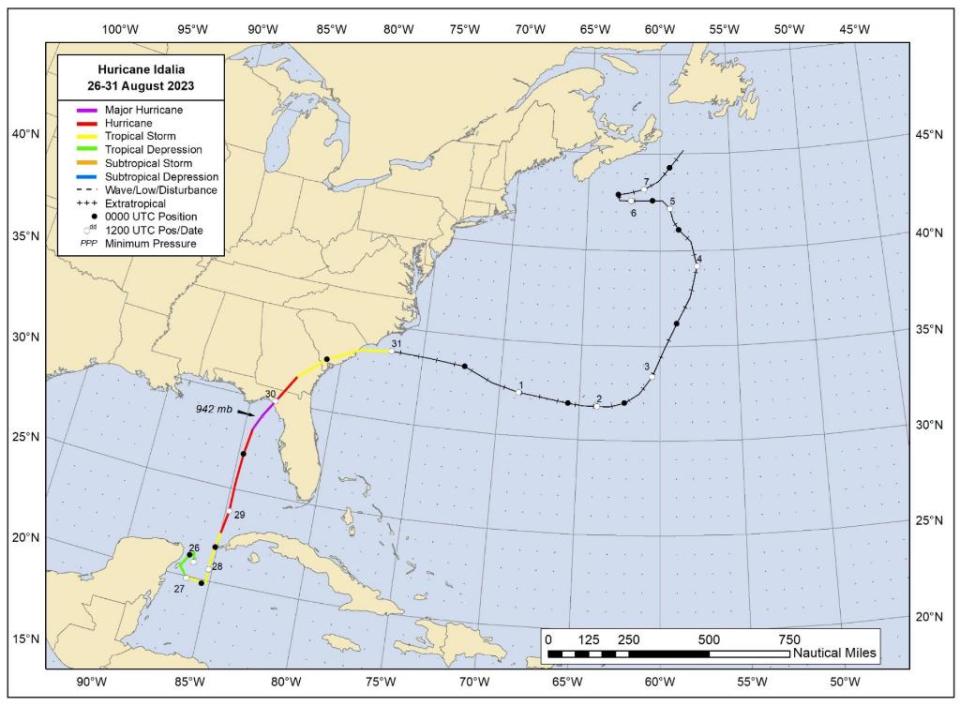
Aug. 26: Tropical depression forms east-southeast of Cancun, Mexico. Winds at 25 mph.
Aug. 27: Tropical storm forms . Winds at 40 mph.
Aug. 29: Idalia become a hurricane with winds at 74 mph as it moves into the Gulf of Mexico.
Aug. 29: Idalia's eye passes about 180 miles west of Key West. Outer-most bands move across Florida Keys and South Florida.
Aug. 30: Idalia's eye passes 110 nautical miles west of Tampa. Bands of heavy rain and gusty winds spread across Southwest and Central Florida.
Aug. 30, 5 a.m. EST: Idalia's winds top out at 132 mph, making it a Category 4 hurricane.
Aug. 30, 7:45 a.m.: Idalia makes landfall near Keaton Beach. Winds at 115 mph, making it a Category 3 hurricane.
Aug. 30, 2 p.m.: Idalia weakens into tropical storm over central Georgia. Winds at 69 mph.
Aug. 31: Idalia moves off the coast of South Carolina near Myrtle Beach. Winds drop to 57 mph.
Aug. 31: Idalia becomes extratropical.
Sept. 2: The center of Idalia passes south of Bermuda.
Sept. 8: What was Idalia dissipates off the coast of Atlantic Canada.
Idalia 3rd strongest hurricane to hit Florida's Big Bend
Idalia was the third-strongest hurricane to affect the Big Bend region of Florida, only behind the 1896 Cedar Key Hurricane and Hurricane Easy in 1950.
Why did Idalia weaken before making landfall in Florida?
Doppler radar indicates Idalia was going through an eyewall replacement cycle and the inner eyewall was opening on the south side around the time it made landfall, the Hurricane Center said.
The estimated peak intensity at landfall is 115 mph, but there is some uncertainty because of the lack of surface data.
The hurricane made landfall in one of the more remote parts of Florida, there were no observations of sustained hurricane-force winds.
Fatalities associated with Hurricane Idalia
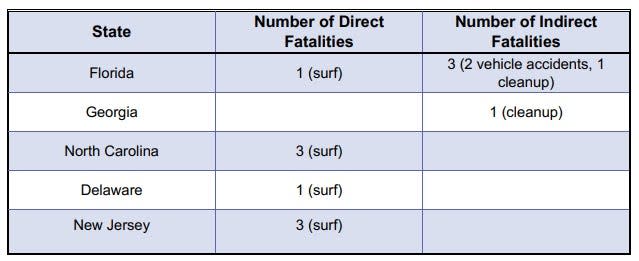
Idalia was responsible for 12 fatalities, all of which occurred in the United States, the Hurricane Center said.
Of the casualties, eight of them were direct and all of them were caused by rough surfand rip currents.
In Brevard County, a 60-year-old man drowned while windsurfing in rough surf due to Idalia’s winds. When Idalia was off the southeast U.S. coast, the associated rough surf took seven lives: three in North Carolina, three in New Jersey, and one in Delaware.
Of the four indirect fatalities, two were due to falling trees during cleanup after the storm’spassage, one in Florida and one in Georgia. The other two indirect fatalities occurred due tovehicle accidents in Florida while the storm was passing through the area.
Idalia brought dangerous storm surge to Florida's Big Bend
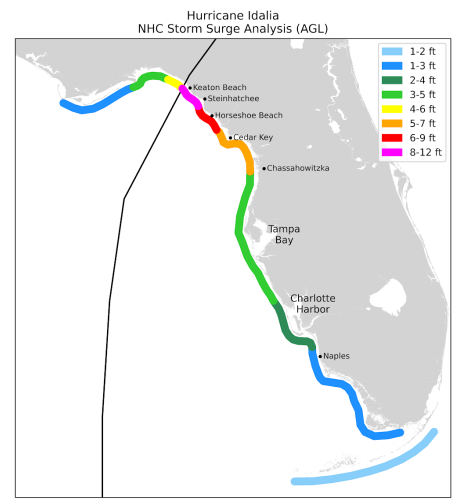
"Hurricane Idalia brought a dangerous storm surge to the Florida Big Bend region, with themaximum inundation of 8 to 12 feet above ground level occurring from Keaton Beach toSteinhatchee," the Hurricane Center said.
The "relatively remote location" where Idalia made landfall makes it unlikely "Bend of Florida, and for this reason, it is unlikely that "the highest storm surge values were observed or measured."
In Keaton Beach, the National Weather Service found evidence of water marks with suspected wave action between 10 and 14 feet.
Storm surge of 2 to 4 feet also affected Georgia and South Carolina coastlines.
Did Idalia spawn any tornadoes?
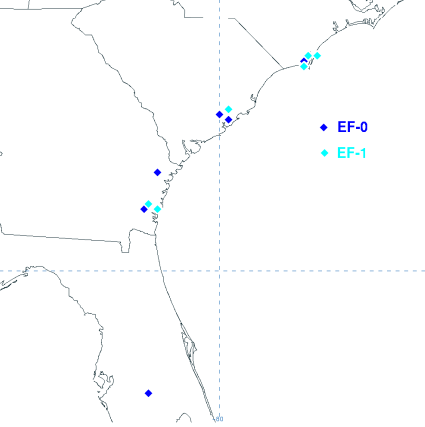
There were 12 tornadoes spawned by Hurricane Idalia as it moved into Florida, Georgia and the Carolinas.
An EF-0 tornado was reported in Florida.
Three EF-0 tornadoes and one EF-1 tornado were reported in Georgia.
Two EF-0 and one EF-1 tornadoes were reported in South Carolina.
Two EF-0 and two EF-1 tornadoes were reported in North Carolina.
Georgia, North Carolina and South Carolina hit by damaging winds
Idalia was still a strong storm after moving through Florida and into the Southeast.
St. Simons and Tybee in Georgia reported wind gusts of 65 mph and 69 mph, respectively.
Tropical-storm-force winds were also reported along the coasts of North and South Carolina. The highest wind speed was reported in Cape Lookout, with sustained winds of 50 mph and a wind gust of 73 mph.
Idalia brought heavy rain to Florida, Southeast US
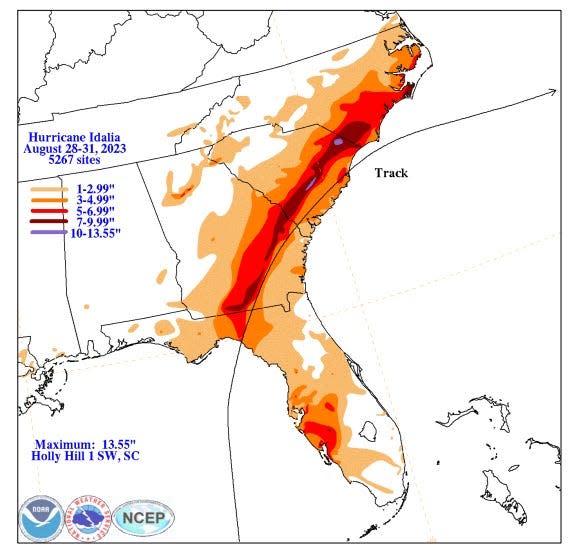
There were widespread totals of 5-7 inches of rain from the Florida's Big Bend to eastern North Carolina.
Rainfall amounts of 7-10 inches were reported from the western side of Idalia in southern Georgia, South Carolina, and far southeastern North Carolina.
The highest rainfall was reported in Holly Hill, South Carolina, which received 13.55 inches.
Trailing rain bands from the hurricane brought 4 to 8 inches of rain occurred to southwest and west-central Florida.
What was the damage estimate left by Idalia?
According to the NOAA National Centers for Environmental Information, the estimated damage from Idalia is $3.6 billion, most of which occurred in Florida’s Big Bend region.
The majority of the damage affected Florida’s agriculture industry in the Big Bend region and northern portions of the state.
Gusty winds and heavy rains caused damage to tens of thousands of structures in portions of southwest, central, and northeast Florida.
This article originally appeared on Treasure Coast Newspapers: National Hurricane Center report on Hurricane Idalia: Impacts, deaths

